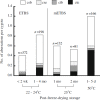Chromosomal integrity and DNA damage in freeze-dried spermatozoa
- PMID: 29699095
- PMCID: PMC5907138
- DOI: 10.1007/s12522-011-0092-7
Chromosomal integrity and DNA damage in freeze-dried spermatozoa
Abstract
Freeze-drying technology may one day be used to preserve mammalian spermatozoa indefinitely without cryopreservation. Freeze-dried mouse spermatozoa stored below 4°C for up to 1 year have maintained the ability to fertilize oocytes and support normal development. The maximum storage period for spermatozoa increases at lower storage temperatures. Freeze-drying, per se, may reduce the integrity of chromosomes in freeze-dried mouse spermatozoa, but induction of chromosomal damage is suppressed if spermatozoa are incubated with divalent cation chelating agents prior to freeze-drying. Nevertheless, chromosomal damage does accumulate in spermatozoa stored at temperatures above 4°C. Currently, no established methods or strategies can prevent or reduce damage accumulation, and damage accumulation during storage is a serious obstacle to advances in freeze-drying technology. Chromosomal integrity of freeze-dried human spermatozoa have roughly background levels of chromosomal damage after storage at 4°C for 1 month, but whether these spermatozoa can produce healthy newborns is unknown. The safety of using freeze-dried human spermatozoa must be evaluated based on the risks of heritable chromosome and DNA damage that accumulates during storage.
Keywords: Chromosome; Cryopreservation; DNA damage; Freeze‐drying; Spermatozoa.
Figures





Similar articles
-
Prevention of high-temperature-induced chromosome damage in mouse spermatozoa freeze-dried using Ca2+ chelator-containing buffer alkalinized with NaOH or KOH.Cryobiology. 2017 Dec;79:71-77. doi: 10.1016/j.cryobiol.2017.08.007. Epub 2017 Aug 30. Cryobiology. 2017. PMID: 28863951
-
Mouse and human spermatozoa can be freeze-dried without damaging their chromosomes.Hum Reprod. 2008 Feb;23(2):233-9. doi: 10.1093/humrep/dem252. Epub 2007 Dec 1. Hum Reprod. 2008. PMID: 18056060
-
Production of mouse fetuses using spermatozoa exposed temporarily to high temperature or continuously to room temperature after freeze-drying in Na+-free/K+-rich EGTA buffer.Cryobiology. 2019 Apr;87:105-109. doi: 10.1016/j.cryobiol.2019.01.010. Epub 2019 Jan 22. Cryobiology. 2019. PMID: 30682339
-
Freeze-dried spermatozoa: A future tool?Reprod Domest Anim. 2017 Apr;52 Suppl 2:248-254. doi: 10.1111/rda.12838. Epub 2016 Oct 18. Reprod Domest Anim. 2017. PMID: 27757990 Review.
-
A study on freeze-drying as a method of preserving mouse sperm.J Reprod Dev. 2011 Apr;57(2):176-82. doi: 10.1262/jrd.10-199e. J Reprod Dev. 2011. PMID: 21551975 Review.
Cited by
-
Reproductive technologies for the generation and maintenance of valuable animal strains.J Reprod Dev. 2018 Jun 22;64(3):209-215. doi: 10.1262/jrd.2018-035. Epub 2018 Apr 14. J Reprod Dev. 2018. PMID: 29657233 Free PMC article. Review.
-
Effect of trehalose on the preservation of freeze-dried mice spermatozoa at room temperature.J Reprod Dev. 2019 Aug 9;65(4):353-359. doi: 10.1262/jrd.2019-058. Epub 2019 May 23. J Reprod Dev. 2019. PMID: 31118350 Free PMC article.
-
Assessing the tolerance to room temperature and viability of freeze-dried mice spermatozoa over long-term storage at room temperature under vacuum.Sci Rep. 2018 Jul 13;8(1):10602. doi: 10.1038/s41598-018-28896-8. Sci Rep. 2018. PMID: 30006561 Free PMC article.
References
-
- Tedder RS, Zuckerman MA, Goldstone AH, Hawkins AE, Fielding A, Briggs EM et al. Hepatitis B transmission from contaminated cryopreservation tank. Lancet, 1995, 346, 137–140 10.1016/S0140‐6736(95)91207‐X - DOI - PubMed
-
- Tomlinson M, Sakkas D. Is a review of standard procedures for cryopreservation needed?: safe and effective cryopreservation—should sperm banks and fertility centres move toward storage in nitrogen vapour?. Hum Reprod, 2000, 15, 2460–2463 10.1093/humrep/15.12.2460 - DOI - PubMed
-
- Wakayama T, Yanagimachi R. Development of normal mice from oocytes injected with freeze‐dried spermatozoa. Nat Biotechnol, 1998, 16, 639–641 10.1038/nbt0798‐639 - DOI - PubMed
-
- Kawase Y, Tachibe T, Jishage K, Suzuki H. Transportation of freeze‐dried mouse spermatozoa under different preservation conditions. J Reprod Dev, 2007, 53, 1169–1174 10.1262/jrd.19037 - DOI - PubMed
-
- Polge C, Smith AU, Parkes AS. Revival of spermatozoa after vitrification and dehydration at low temperatures. Nature, 1949, 164, 666 10.1038/164666a0 - DOI - PubMed
Publication types
LinkOut - more resources
Full Text Sources
